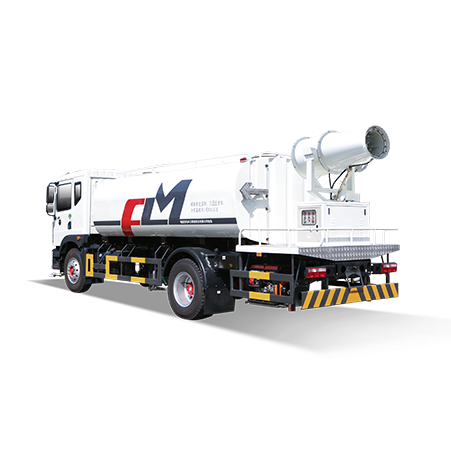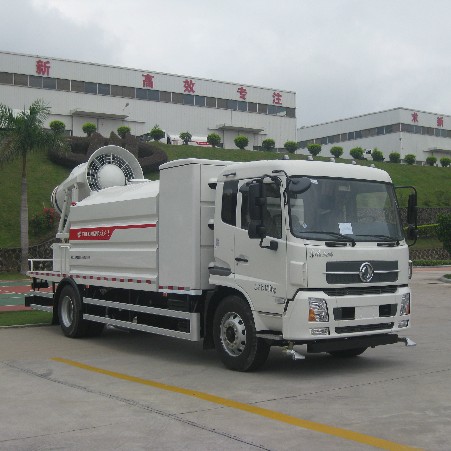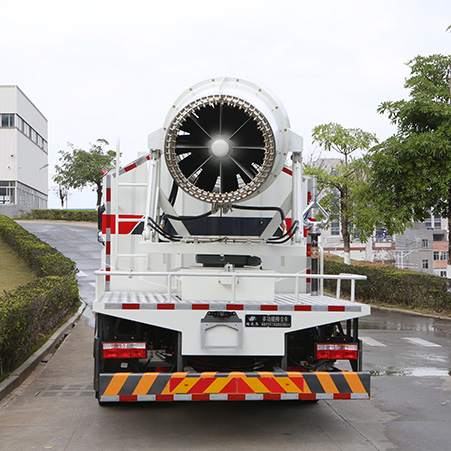Though seemingly harmless, dust can be a significant problem, especially in industrial, construction, and mining environments. Dust can cause severe health issues, environmental damage, and operational inefficiencies when left unchecked. Fine particles can linger in the air, posing respiratory hazards to workers and nearby communities. In addition to health risks, dust can obscure visibility, leading to accidents, and damage machinery, reducing its lifespan and increasing maintenance costs.
Dust suppression is a critical practice to mitigate these issues. Effective dust control not only protects the health of workers and residents but also preserves the environment and improves operational efficiency. One of the most efficient tools in this endeavor is the dust suppression truck.

What are Dust Suppression Trucks?
Dust suppression trucks are specialized vehicles equipped with systems to disperse water or other dust control agents. They typically feature large tanks to hold the liquid, powerful pumps to pressurize the liquid, and a series of nozzles to distribute it evenly across surfaces. These trucks are designed to tackle a variety of dust-generating environments, from construction sites and quarries to unpaved roads and mining operations.
The Importance of Dust Suppression
- Health and Safety: Inhalation of dust particles can cause respiratory diseases such as silicosis, asthma, and other chronic lung conditions. Keeping dust under control ensures the well-being of workers and the surrounding population.
- Environmental Protection: Dust can harm local flora and fauna, polluting water sources and soil. Suppressing dust helps in preserving the local ecosystem.
- Regulatory Compliance: Many regions have stringent regulations regarding dust emissions. Effective dust suppression ensures compliance with these regulations, avoiding hefty fines and legal issues.
- Operational Efficiency: Dust can interfere with machinery, causing frequent breakdowns and maintenance needs. Suppressing dust helps in maintaining the efficiency and longevity of equipment.
- Community Relations: For businesses operating near residential areas, controlling dust emissions is vital for maintaining good community relations and preventing complaints.
How Dust Suppression Trucks Work
- Water Tank: The core of the dust suppression truck is a large tank that holds water or a dust control solution. The size of the tank can vary, typically ranging from 2,000 to 20,000 gallons, depending on the truck’s size and the area it needs to cover.
- Pump System: A powerful pump system is used to pressurize the water. The pump’s strength determines the distance and coverage area of the spray, ensuring the water can reach even distant or hard-to-reach areas.
- Spray Nozzles: The truck is equipped with multiple spray nozzles, strategically placed to provide even coverage. These nozzles can be adjusted to control the spray pattern, from a fine mist to a heavier stream, depending on the dust suppression needs.
- Control System: Modern dust suppression trucks often come with sophisticated control systems that allow the operator to adjust the flow rate, pressure, and spray pattern. Some systems are automated, using sensors to detect dust levels and adjust spraying accordingly.
- Distribution: As the truck moves through the area, the pressurized water is sprayed through the nozzles, settling the dust particles onto the ground. This process not only prevents dust from becoming airborne but also helps to keep surfaces damp, reducing future dust generation.
Types of Dust Suppression Trucks
There are several types of dust suppression trucks, each designed for specific environments and applications.
- Standard Water Trucks: These are the most common type, equipped with a large water tank and basic spray nozzles. They are versatile and used in a variety of settings, from construction sites to agricultural fields.
- High-Pressure Water Trucks: These trucks feature more powerful pumps and advanced nozzle systems, capable of delivering water at higher pressures. They are ideal for heavy-duty applications such as mining operations and large construction projects.
- Chemical Additive Trucks: In situations where water alone is not sufficient, these trucks mix chemical additives into the water to enhance dust suppression. These chemicals help bind dust particles together, making them heavier and less likely to become airborne.
- Fogging Trucks: These trucks use high-pressure nozzles to create a fine mist or fog that can trap dust particles more effectively. They are particularly useful in areas where a light touch is needed, such as residential construction zones.
- Multi-Purpose Trucks: Some trucks are designed to handle multiple functions, including dust suppression, fire fighting, and even road cleaning. These versatile vehicles are equipped with various nozzles and systems to switch between tasks as needed.
Advantages and Disadvantages
Advantages
- Effective Dust Control: Dust suppression trucks are highly effective in controlling dust, reducing health risks, and improving visibility and safety.
- Versatility: They can be used in a wide range of environments and can be adapted to different dust control needs with adjustable nozzles and control systems.
- Compliance: Using dust suppression trucks helps businesses comply with environmental regulations, avoiding fines and legal issues.
- Operational Efficiency: By reducing dust, these trucks help maintain machinery and equipment, reducing maintenance costs and downtime.
Disadvantages
- Water Usage: Dust suppression trucks require significant amounts of water, which can be a concern in water-scarce regions.
- Cost: The initial investment and operating costs of dust suppression trucks can be high, particularly for advanced models with sophisticated systems.
- Maintenance: These trucks require regular maintenance to ensure their components, such as pumps and nozzles, are functioning correctly.
- Chemical Concerns: When using chemical additives, there is a need to ensure they are environmentally safe and do not cause additional pollution.

Dust suppression trucks are indispensable tools in managing dust in various industrial and construction environments. By effectively controlling dust, these trucks play a crucial role in protecting health, preserving the environment, and enhancing operational efficiency. While they come with certain costs and considerations, their benefits far outweigh the drawbacks, making them a valuable asset for any dust-prone operation.
FAQs
How often should dust suppression trucks be used?
The frequency of use depends on the environment and the level of dust generation. High-dust areas like mines may require daily use, while less dusty areas might need weekly treatments.
Can dust suppression trucks use substances other than water?
Yes, some trucks can use chemical additives mixed with water to enhance dust suppression, especially in environments where water alone is insufficient.
Are dust suppression trucks environmentally friendly?
When used correctly, dust suppression trucks are environmentally friendly. However, it’s essential to consider water usage and the type of chemicals used to ensure they do not cause harm.
What maintenance do dust suppression trucks require?
Regular maintenance includes checking and servicing the pump system, nozzles, and control systems, as well as ensuring the tank is clean and free from contamination.
Can dust suppression trucks be used in residential areas?
Yes, trucks equipped with fogging systems or fine mist nozzles are suitable for residential areas, where a gentle approach is necessary to avoid disturbing the community.







